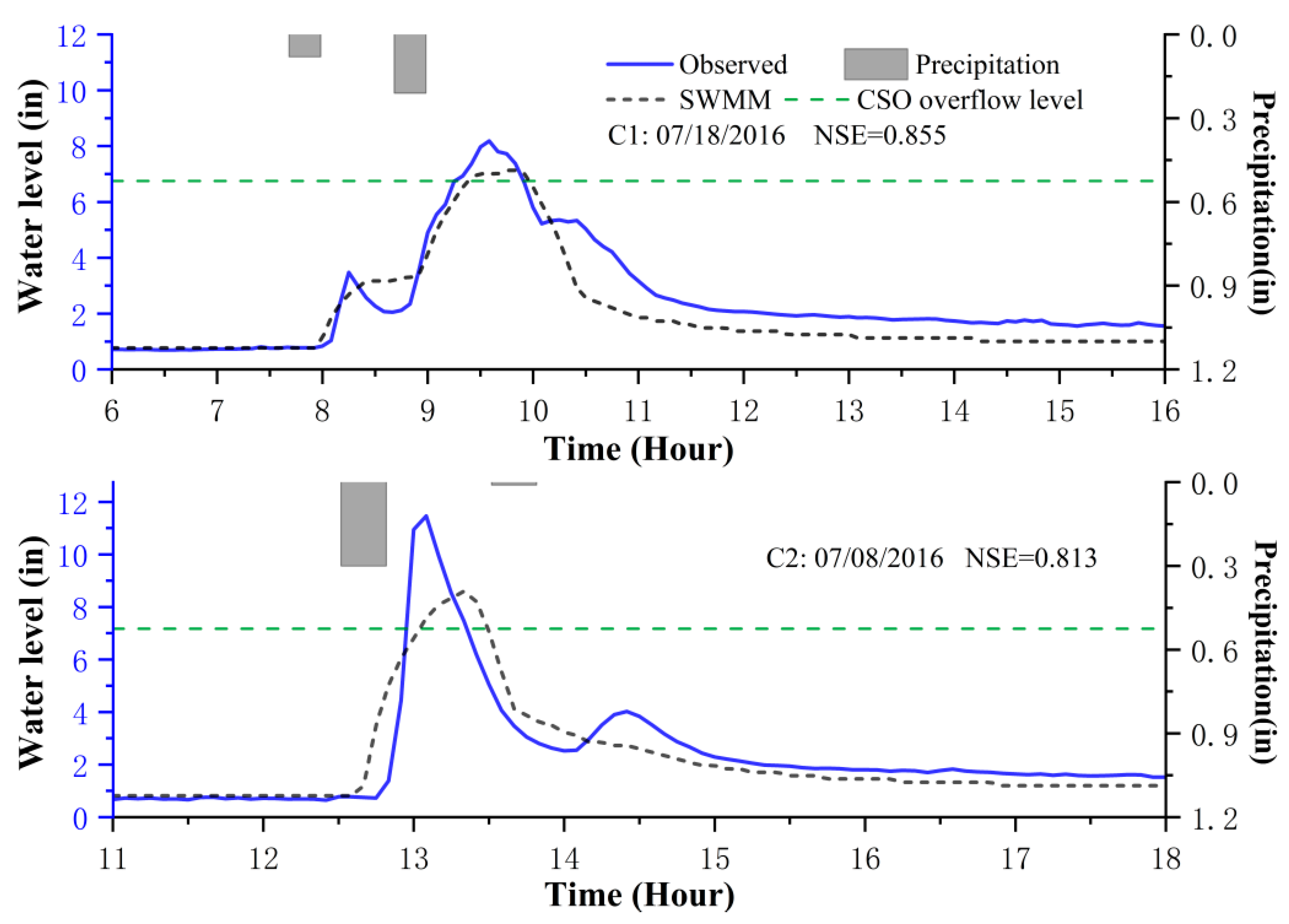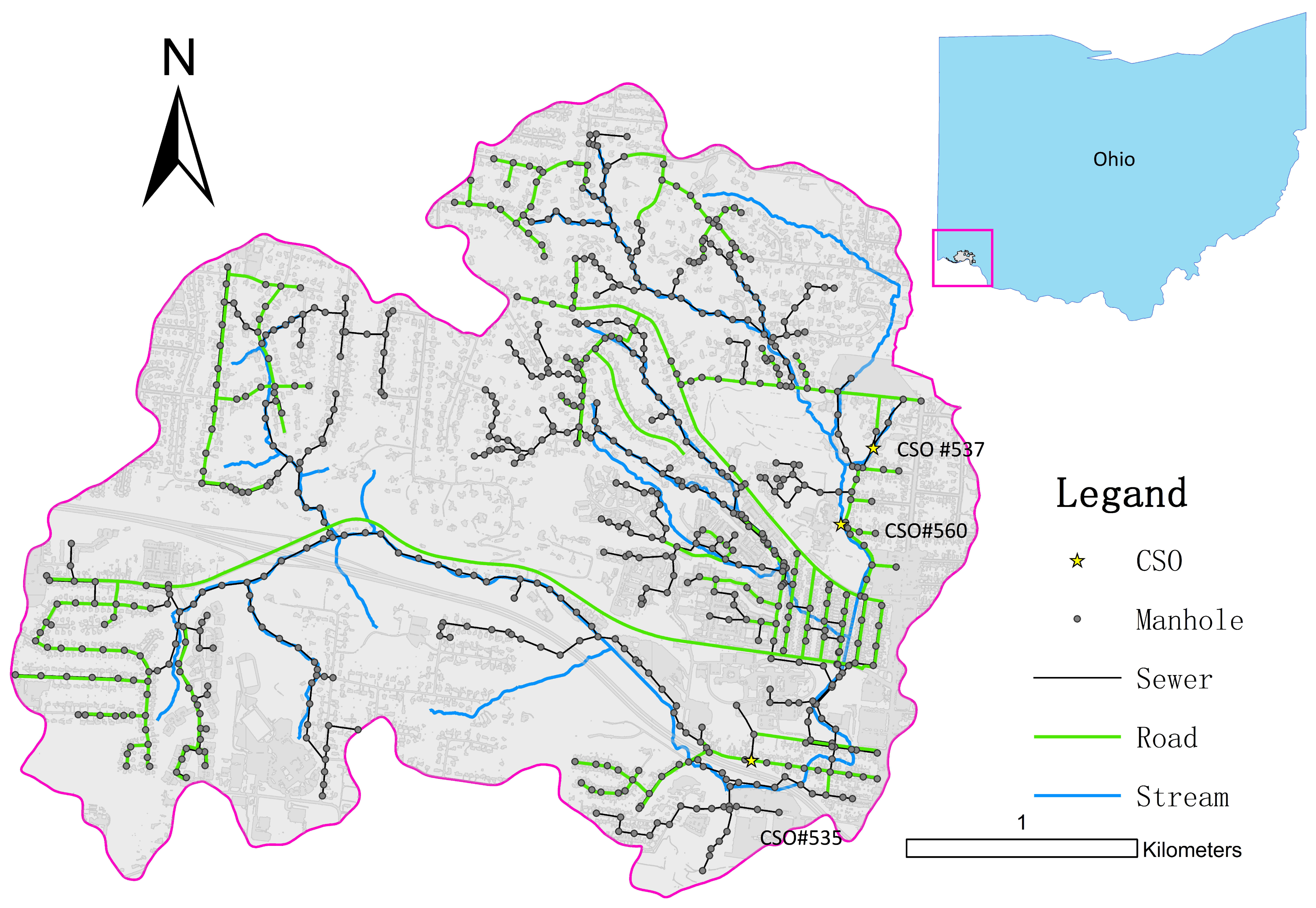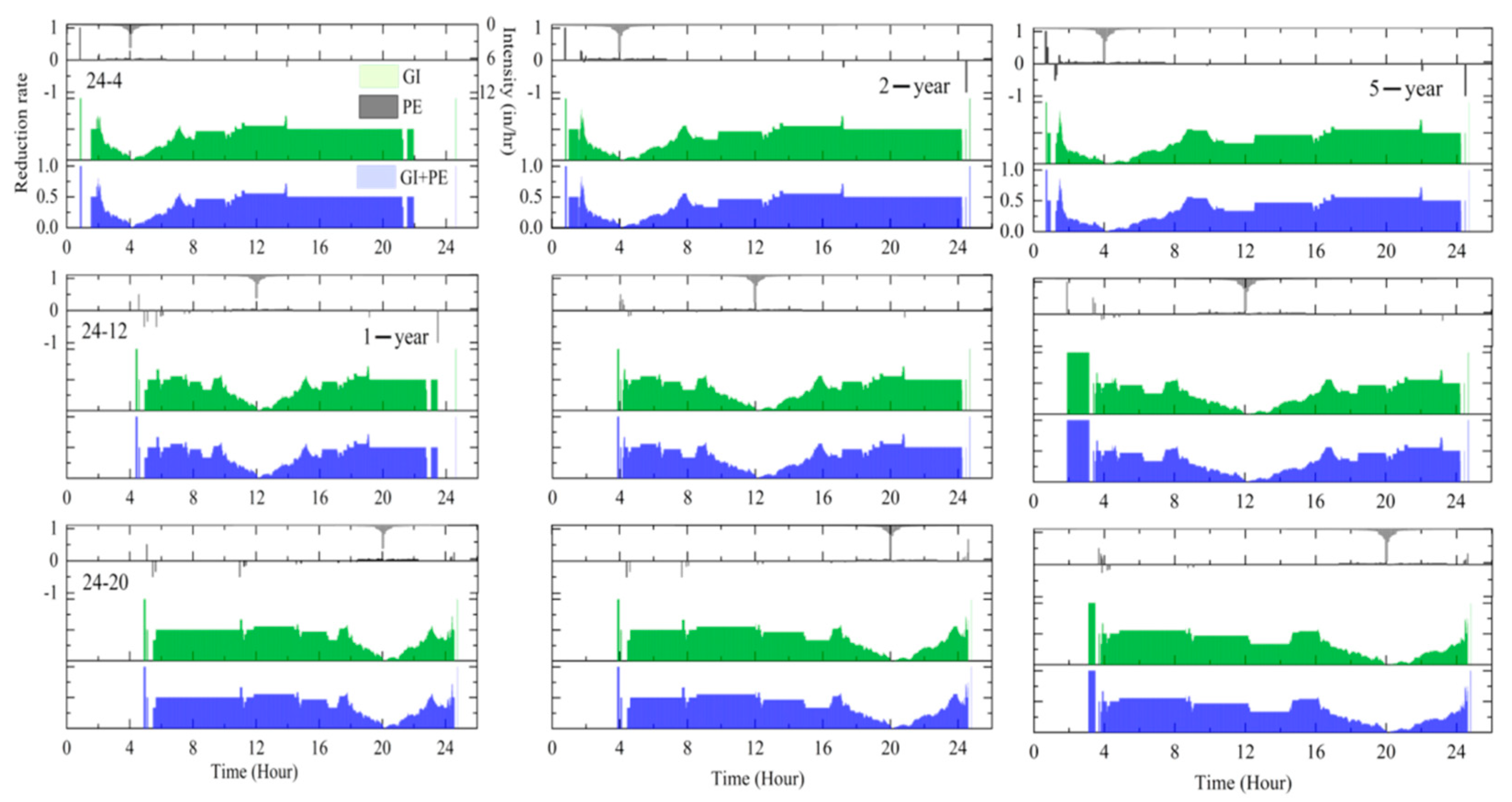Developing Green Infrastructure Strategies Based on the Analysis of Sewer System Critical Components
Abstract
:1. Introduction
2. Materials and Methods
2.1. Study Area
2.2. Design Storms
2.3. Performance Measurements
2.4. Identify Critical Pipes
2.5. Scenario Development
3. Results and Discussion
3.1. Sewer Network Performance under Different Rainfalls
3.2. Identification of Critical Pipes
3.3. Road Inundation in the Baseline Scenario
3.4. Retrofit Effect
4. Conclusions
Author Contributions
Funding
Institutional Review Board Statement
Informed Consent Statement
Data Availability Statement
Acknowledgments
Conflicts of Interest
Appendix A
| NSE | Model Performance |
|---|---|
| 0.75 < NSE < 1 | Very good |
| 0.65 < NSE < 0.75 | Good |
| 0.5 < NSE < 0.65 | Satisfactory |
| NSE ≤ 0.5 | Unsatisfactory |
| NSE < 0 | Not credible |
| Parameter | Category | Calibration Value | Calibration Interval/Design Parameter |
|---|---|---|---|
| Manning’s roughness coefficient | Storm conduits Pipe Street Stream | 0.022 0.015/0.017 0.017 0.04 | 0.022 0.011–0.026 0.011–0.035 0.03–0.07 |
| Manning’s N | N-Imperv N-Perv | 0.011 0.11 | 0.011–0.015 0.06–0.41 |
| D_storage | Impervious Pervious | 0.1 0.3 | 0.05–0.1 0.1–0.3 |


| Time | Overflow Records | Simulation Results |
|---|---|---|
| June 2014 | 6/4/2014 | 6/4/2014 |
| September 2015 | 9/5/2015 | 9/5/2015 |
| August 2016 | 8/15/2016 8/17/2016 8/28/2016 | 8/15/2016 8/17/2016 8/28/2016 |
| June 2017 | 6/23/2017 | 6/23/2017 6/18/2017 |
| July 2017 | 7/13/2017 | 7/13/2017 7/7/2017 |
References
- Mohanty, M.P.; Mudgil, S.; Karmakar, S. Flood Management in India: A Focussed Review on the Current Status and Future Challenges. Int. J. Disaster Risk Reduct. 2020, 49, 101660. [Google Scholar] [CrossRef]
- Wang, W.; Yang, S.; Stanley, H.E.; Gao, J. Local Floods Induce Large-Scale Abrupt Failures of Road Networks. Nat. Commun. 2019, 10, 2114. [Google Scholar] [CrossRef]
- Hosseinzadehtalaei, P.; Ishadi, N.K.; Tabari, H.; Willems, P. Climate Change Impact Assessment on Pluvial Flooding Using a Distribution-Based Bias Correction of Regional Climate Model Simulations. J. Hydrol. 2021, 598, 126239. [Google Scholar] [CrossRef]
- Jha, M.; Afreen, S. Flooding Urban Landscapes: Analysis Using Combined Hydrodynamic and Hydrologic Modeling Approaches. Water 2020, 12, 1986. [Google Scholar] [CrossRef]
- Kourtis, I.M.; Tsihrintzis, V.A. Adaptation of Urban Drainage Networks to Climate Change: A Review. Sci. Total Environ. 2021, 771, 145431. [Google Scholar] [CrossRef]
- Arnone, E.; Pumo, D.; Francipane, A.; La Loggia, G.; Noto, L.V. The Role of Urban Growth, Climate Change, and Their Interplay in Altering Runoff Extremes. Hydrol. Process. 2018, 32, 1755–1770. [Google Scholar] [CrossRef]
- Skougaard Kaspersen, P.; Høegh Ravn, N.; Arnbjerg-Nielsen, K.; Madsen, H.; Drews, M. Comparison of the Impacts of Urban Development and Climate Change on Exposing European Cities to Pluvial Flooding. Hydrol. Earth Syst. Sci. 2017, 21, 4131–4147. [Google Scholar] [CrossRef] [Green Version]
- Zhou, Q.; Leng, G.; Su, J.; Ren, Y. Comparison of Urbanization and Climate Change Impacts on Urban Flood Volumes: Importance of Urban Planning and Drainage Adaptation. Sci. Total Environ. 2019, 658, 24–33. [Google Scholar] [CrossRef] [PubMed]
- Qin, H.; Li, Z.; Fu, G. The Effects of Low Impact Development on Urban Flooding under Different Rainfall Characteristics. J. Environ. Manag. 2013, 129, 577–585. [Google Scholar] [CrossRef] [PubMed] [Green Version]
- Babovic, F.; Mijic, A. The Development of Adaptation Pathways for the Long-term Planning of Urban Drainage Systems. J. Flood Risk Manag. 2019, 12, e12538. [Google Scholar] [CrossRef] [Green Version]
- Kang, N.; Kim, S.; Kim, Y.; Noh, H.; Hong, S.; Kim, H. Urban Drainage System Improvement for Climate Change Adaptation. Water 2016, 8, 268. [Google Scholar] [CrossRef] [Green Version]
- Casal-Campos, A.; Fu, G.; Butler, D.; Moore, A. An Integrated Environmental Assessment of Green and Gray Infrastructure Strategies for Robust Decision Making. Environ. Sci. Technol. 2015, 49, 8307–8314. [Google Scholar] [CrossRef] [PubMed] [Green Version]
- Zhou, Q. A Review of Sustainable Urban Drainage Systems Considering the Climate Change and Urbanization Impacts. Water 2014, 6, 976–992. [Google Scholar] [CrossRef]
- Barbosa, A.E.; Fernandes, J.N.; David, L.M. Key Issues for Sustainable Urban Stormwater Management. Water Res. 2012, 46, 6787–6798. [Google Scholar] [CrossRef]
- Chen, W.; Wang, W.; Huang, G.; Wang, Z.; Lai, C.; Yang, Z. The Capacity of Grey Infrastructure in Urban Flood Management: A Comprehensive Analysis of Grey Infrastructure and the Green-Grey Approach. Int. J. Disaster Risk Reduct. 2021, 54, 102045. [Google Scholar] [CrossRef]
- Pour, S.H.; Wahab, A.K.A.; Shahid, S.; Asaduzzaman, M.; Dewan, A. Low Impact Development Techniques to Mitigate the Impacts of Climate-Change-Induced Urban Floods: Current Trends, Issues and Challenges. Sustain. Cities Soc. 2020, 62, 102373. [Google Scholar] [CrossRef]
- Fu, X. Assessment of Green Infrastructure Performance through an Urban Resilience Lens. J. Clean. Prod. 2021, 11, 125146. [Google Scholar] [CrossRef]
- Chatzimentor, A.; Apostolopoulou, E.; Mazaris, A.D. A Review of Green Infrastructure Research in Europe: Challenges and Opportunities. Landsc. Urban. Plan. 2020, 198, 103775. [Google Scholar] [CrossRef]
- Eckart, K.; McPhee, Z.; Bolisetti, T. Performance and Implementation of Low Impact Development—A Review. Sci. Total Environ. 2017, 607–608, 413–432. [Google Scholar] [CrossRef]
- Venkataramanan, V.; Lopez, D.; McCuskey, D.J.; Kiefus, D.; McDonald, R.I.; Miller, W.M.; Packman, A.I.; Young, S.L. Knowledge, Attitudes, Intentions, and Behavior Related to Green Infrastructure for Flood Management: A Systematic Literature Review. Sci. Total Environ. 2020, 720, 137606. [Google Scholar] [CrossRef]
- Caparrós-Martínez, J.L.; Milán-García, J.; Rueda-López, N.; de Pablo-Valenciano, J. Green Infrastructure and Water: An Analysis of Global Research. Water 2020, 12, 1760. [Google Scholar] [CrossRef]
- Fu, X.; Hopton, M.E.; Wang, X.; Goddard, H.; Liu, H. A Runoff Trading System to Meet Watershed-Level Stormwater Reduction Goals with Parcel-Level Green Infrastructure Installation. Sci. Total Environ. 2019, 689, 1149–1159. [Google Scholar] [CrossRef]
- Seo, M.; Jaber, F.; Srinivasan, R.; Jeong, J. Evaluating the Impact of Low Impact Development (LID) Practices on Water Quantity and Quality under Different Development Designs Using SWAT. Water 2017, 9, 193. [Google Scholar] [CrossRef]
- Zhang, K.; Chui, T.F.M. A Comprehensive Review of Spatial Allocation of LID-BMP-GI Practices: Strategies and Optimization Tools. Sci. Total Environ. 2018, 621, 915–929. [Google Scholar] [CrossRef]
- Czemiel Berndtsson, J. Green Roof Performance towards Management of Runoff Water Quantity and Quality: A Review. Ecol. Eng. 2010, 36, 351–360. [Google Scholar] [CrossRef]
- Bliss, D.J.; Neufeld, R.D.; Ries, R.J. Storm Water Runoff Mitigation Using a Green Roof. Environ. Eng. Sci. 2009, 26, 407–418. [Google Scholar] [CrossRef]
- Mangangka, I.R.; Liu, A.; Egodawatta, P.; Goonetilleke, A. Performance Characterisation of a Stormwater Treatment Bioretention Basin. J. Environ. Manag. 2015, 150, 173–178. [Google Scholar] [CrossRef] [Green Version]
- Chapman, C.; Horner, R.R. Performance Assessment of a Street-Drainage Bioretention System. Water Environ. Res. 2010, 82, 109–119. [Google Scholar] [CrossRef] [PubMed]
- Jamali, B.; Bach, P.M.; Deletic, A. Rainwater Harvesting for Urban Flood Management—An Integrated Modelling Framework. Water Res. 2020, 171, 115372. [Google Scholar] [CrossRef] [PubMed]
- Autixier, L.; Mailhot, A.; Bolduc, S.; Madoux-Humery, A.-S.; Galarneau, M.; Prévost, M.; Dorner, S. Evaluating Rain Gardens as a Method to Reduce the Impact of Sewer Overflows in Sources of Drinking Water. Sci. Total Environ. 2014, 499, 238–247. [Google Scholar] [CrossRef] [PubMed]
- Roebuck, R.M.; Oltean-Dumbrava, C.; Tait, S. Whole Life Cost Performance of Domestic Rainwater Harvesting Systems in the United Kingdom: Cost Performance of Domestic Rainwater Harvesting Systems. Water Environ. J. 2011, 25, 355–365. [Google Scholar] [CrossRef]
- Soulis, K.X.; Valiantzas, J.D.; Ntoulas, N.; Kargas, G.; Nektarios, P.A. Simulation of Green Roof Runoff under Different Substrate Depths and Vegetation Covers by Coupling a Simple Conceptual and a Physically Based Hydrological Model. J. Environ. Manag. 2017, 200, 434–445. [Google Scholar] [CrossRef] [PubMed]
- Lee, J.G.; Borst, M.; Brown, R.A.; Rossman, L.; Simon, M.A. Modeling the Hydrologic Processes of a Permeable Pavement System. J. Hydrol. Eng. 2015, 20, 04014070. [Google Scholar] [CrossRef]
- Chopra, M.; Kakuturu, S.; Ballock, C.; Spence, J.; Wanielista, M. Effect of Rejuvenation Methods on the Infiltration Rates of Pervious Concrete Pavements. J. Hydrol. Eng. 2010, 15, 426–433. [Google Scholar] [CrossRef]
- Imran, H.M.; Akib, S.; Karim, M.R. Permeable Pavement and Stormwater Management Systems: A Review. Environ. Technol. 2013, 34, 2649–2656. [Google Scholar] [CrossRef] [Green Version]
- Kamali, M.; Delkash, M.; Tajrishy, M. Evaluation of Permeable Pavement Responses to Urban Surface Runoff. J. Environ. Manag. 2017, 187, 43–53. [Google Scholar] [CrossRef] [PubMed]
- Ahiablame, L.; Shakya, R. Modeling Flood Reduction Effects of Low Impact Development at a Watershed Scale. J. Environ. Manag. 2016, 171, 81–91. [Google Scholar] [CrossRef]
- Raei, E.; Reza Alizadeh, M.; Reza Nikoo, M.; Adamowski, J. Multi-Objective Decision-Making for Green Infrastructure Planning (LID-BMPs) in Urban Storm Water Management under Uncertainty. J. Hydrol. 2019, 579, 124091. [Google Scholar] [CrossRef]
- Mei, C.; Liu, J.; Wang, H.; Yang, Z.; Ding, X.; Shao, W. Integrated Assessments of Green Infrastructure for Flood Mitigation to Support Robust Decision-Making for Sponge City Construction in an Urbanized Watershed. Sci. Total Environ. 2018, 639, 1394–1407. [Google Scholar] [CrossRef]
- Gong, Y.; Chen, Y.; Yu, L.; Li, J.; Pan, X.; Shen, Z.; Xu, X.; Qiu, Q. Effectiveness Analysis of Systematic Combined Sewer Overflow Control Schemes in the Sponge City Pilot Area of Beijing. IJERPH 2019, 16, 1503. [Google Scholar] [CrossRef] [Green Version]
- U.S. Environmental Protection Agency (USEPA). Reducing Stormwater Costs through Low Impact Development (LID) Strategies and Practices; EPA 841-F-07-006; USEPA Nonpoint Source Control Branch: Washington, DC, USA, 2007.
- Randall, M.; Sun, F.; Zhang, Y.; Jensen, M.B. Evaluating Sponge City Volume Capture Ratio at the Catchment Scale Using SWMM. J. Environ. Manag. 2019, 246, 745–757. [Google Scholar] [CrossRef]
- Carter, J.G.; Handley, J.; Butlin, T.; Gill, S. Adapting Cities to Climate Change—Exploring the Flood Risk Management Role of Green Infrastructure Landscapes. J. Environ. Plan. Manag. 2018, 61, 1535–1552. [Google Scholar] [CrossRef] [Green Version]
- Palla, A.; Gnecco, I. Hydrologic Modeling of Low Impact Development Systems at the Urban Catchment Scale. J. Hydrol. 2015, 528, 361–368. [Google Scholar] [CrossRef]
- Jarden, K.M.; Jefferson, A.J.; Grieser, J.M. Assessing the Effects of Catchment-Scale Urban Green Infrastructure Retrofits on Hydrograph Characteristics: Hydrologic Effects of Catchment-Scale Green Infrastructure Retrofits. Hydrol. Process. 2016, 30, 1536–1550. [Google Scholar] [CrossRef]
- Carson, T.B.; Marasco, D.E.; Culligan, P.J.; McGillis, W.R. Hydrological Performance of Extensive Green Roofs in New York City: Observations and Multi-Year Modeling of Three Full-Scale Systems. Environ. Res. Lett. 2013, 8, 024036. [Google Scholar] [CrossRef]
- Wang, X.; Shuster, W.; Pal, C.; Buchberger, S.; Bonta, J.; Avadhanula, K. Low Impact Development Design—Integrating Suitability Analysis and Site Planning for Reduction of Post-Development Stormwater Quantity. Sustainability 2010, 2, 2467–2482. [Google Scholar] [CrossRef] [Green Version]
- Wang, W.; Yang, S.; Gao, J.; Hu, F.; Zhao, W.; Stanley, H.E. An Integrated Approach for Assessing the Impact of Large-Scale Future Floods on a Highway Transport System. Risk Anal. 2020, 40, 1780–1794. [Google Scholar] [CrossRef] [PubMed]
- Schifman, L.A.; Herrmann, D.L.; Shuster, W.D.; Ossola, A.; Garmestani, A.; Hopton, M.E. Situating Green Infrastructure in Context: A Framework for Adaptive Socio-Hydrology in Cities. Water Resour. Res. 2017, 53, 10139–10154. [Google Scholar] [CrossRef]
- Zeng, S.; Guo, H.; Dong, X. Understanding the Synergistic Effect between LID Facility and Drainage Network: With a Comprehensive Perspective. J. Environ. Manag. 2019, 246, 849–859. [Google Scholar] [CrossRef]
- Gao, J.; Buldyrev, S.V.; Stanley, H.E.; Havlin, S. Networks Formed from Interdependent Networks. Nat. Phys. 2012, 8, 40–48. [Google Scholar] [CrossRef] [Green Version]
- Ouyang; Min. Review on Modeling and Simulation of Interdependent Critical Infrastructure Systems. Reliab. Eng. Syst. Saf. 2014, 121, 43–60. [Google Scholar] [CrossRef]
- Butler, D.; Digman, C.; Makropoulos, C.; Davies, J.W. Urban Drainage, 4th ed.; CRC Press: Boca Raton, FL, USA, 2018. [Google Scholar] [CrossRef]
- City of Cincinnati. Street Restoration Manual. 2012. Available online: https://www.cincinnati-oh.gov/dote/permits-licenses/dote-resource-center/subdivision-development/subdivision-development-streets-manual/ (accessed on 15 May 2019).
- Chen, W.; Huang, G.; Zhang, H.; Wang, W. Urban Inundation Response to Rainstorm Patterns with a Coupled Hydrodynamic Model: A Case Study in Haidian Island, China. J. Hydrol. 2018, 564, 1022–1035. [Google Scholar] [CrossRef]
- Rai, P.K.; Chahar, B.R.; Dhanya, C.T. GIS-Based SWMM Model for Simulating the Catchment Response to Flood Events. Hydrol. Res. 2017, 48, 384–394. [Google Scholar] [CrossRef]
- Nash, J.E.; Sutcliffe, I.V. River Flow Forecasting through Conceptual Models. J. Hydrol. 1970, 10, 282–290. [Google Scholar] [CrossRef]
- Moriasi, D.N.; Arnold, J.G.; van Liew, M.W.; Bingner, R.L.; Harmel, R.D.; Veith, T.L. Model Evaluation Guidelines for Systematic Quantification of Accuracy in Watershed Simulations. Trans. ASABE 2007, 50, 885–900. [Google Scholar] [CrossRef]
- Santhi, C.; Arnold, J.G.; Williams, J.R.; Dugas, W.A.; Srinivasan, R.; Hauck, L.M. Validation of the Swat Model on a Large Rwer Basin with Point and Nonpoint Sources. J. Am. Water Resour. Assoc. 2001, 37, 1169–1188. [Google Scholar] [CrossRef]









| Soil | Surface | ||
|---|---|---|---|
| Thickness (in) | 18 | Berm Height (in) | 0 |
| Porosity (volume fraction) | 0.5 | Vegetation Volume Fraction | 0.5 |
| Field Capacity (volume fraction) | 0.2 | Surface Roughness (Manning’s N) | 0 |
| Wilting Point (volume fraction) | 0.1 | Surface Slope (percent) | 1.0 |
| Conductivity (in/hr) | 0.5 | ||
| Conductivity Slop (dimensionless) | 10.0 | ||
| Suction Head (in) | 3.5 |
| Shape | Diameter before Enlargement (Feet) | Diameter after Enlargement (Feet) |
|---|---|---|
| Circular | 0.667 | 1.334 |
| Circular | 0.83 | 1.66 |
| Circular | 1 | 2 |
| Circular | 1.12 | 2.24 |
| Circular | 1.25 | 2.5 |
| Circular | 1.5 | 3 |
| Circular | 1.75 | 3.5 |
| Circular | 2 | 4 |
| Circular | 2.5 | 5 |
| Short-Term Rainfall | 2-0.5 | 2-1 | 2-1.5 | ||||||
|---|---|---|---|---|---|---|---|---|---|
| PE | GI | GI + PE | PE | GI | GI + PE | PE | GI | GI + PE | |
| 1-year | 2.31 | 12.95 | 13.49 | 1.78 | 13.68 | 14.23 | 2.16 | 15.83 | 16.26 |
| 2-year | 2.39 | 11.76 | 12.55 | 2.09 | 13.52 | 14.02 | 2.83 | 13.60 | 14.46 |
| 5-year | 2.18 | 10.16 | 11.21 | 2.05 | 12.49 | 13.18 | 1.94 | 11.75 | 12.70 |
| 10-year | 2.15 | 9.55 | 10.17 | 1.65 | 10.83 | 11.50 | 2.19 | 10.85 | 11.83 |
| 25-year | 1.84 | 8.17 | 8.79 | 1.85 | 9.90 | 10.57 | 2.34 | 9.16 | 10.52 |
| 50-year | 2.28 | 7.19 | 7.91 | 1.73 | 8.62 | 9.82 | 1.22 | 8.68 | 9.94 |
| 100-year | 1.76 | 6.60 | 7.86 | 1.92 | 8.44 | 9.13 | 2.10 | 7.89 | 9.27 |
| Average | 2.13 | 9.48 | 10.29 | 1.88 | 11.07 | 11.78 | 2.11 | 11.11 | 12.14 |
| Long-Term Rainfall | 24-4 | 24-12 | 24-20 | ||||||
|---|---|---|---|---|---|---|---|---|---|
| PE | GI | GI + PE | PE | GI | GI + PE | PE | GI | GI + PE | |
| 1-year | 0.45 | 33.38 | 33.50 | 0.19 | 28.91 | 28.89 | 0.30 | 30.77 | 30.78 |
| 2-year | 0.47 | 37.59 | 37.77 | 0.47 | 30.68 | 30.77 | 0.35 | 31.08 | 31.24 |
| 5-year | 0.51 | 35.43 | 35.68 | 0.62 | 33.79 | 33.92 | 0.62 | 30.89 | 31.14 |
| 10-year | 0.73 | 34.02 | 34.28 | 0.77 | 34.57 | 34.80 | 0.77 | 34.87 | 35.10 |
| 25-year | 0.81 | 30.28 | 30.64 | 0.94 | 26.36 | 26.59 | 0.95 | 28.64 | 28.98 |
| 50-year | 0.91 | 28.28 | 28.69 | 1.09 | 24.62 | 24.99 | 1.12 | 24.49 | 24.82 |
| 100-year | 1.11 | 26.31 | 26.68 | 1.32 | 23.63 | 23.96 | 1.28 | 23.57 | 23.95 |
| Average | 0.71 | 32.18 | 32.46 | 0.77 | 28.94 | 29.13 | 0.77 | 29.18 | 29.43 |
Publisher’s Note: MDPI stays neutral with regard to jurisdictional claims in published maps and institutional affiliations. |
© 2021 by the authors. Licensee MDPI, Basel, Switzerland. This article is an open access article distributed under the terms and conditions of the Creative Commons Attribution (CC BY) license (https://creativecommons.org/licenses/by/4.0/).
Share and Cite
Shen, C.; Xia, H.; Fu, X.; Wang, X.; Wang, W. Developing Green Infrastructure Strategies Based on the Analysis of Sewer System Critical Components. Water 2021, 13, 2694. https://doi.org/10.3390/w13192694
Shen C, Xia H, Fu X, Wang X, Wang W. Developing Green Infrastructure Strategies Based on the Analysis of Sewer System Critical Components. Water. 2021; 13(19):2694. https://doi.org/10.3390/w13192694
Chicago/Turabian StyleShen, Chen, Haishan Xia, Xin Fu, Xinhao Wang, and Weiping Wang. 2021. "Developing Green Infrastructure Strategies Based on the Analysis of Sewer System Critical Components" Water 13, no. 19: 2694. https://doi.org/10.3390/w13192694
APA StyleShen, C., Xia, H., Fu, X., Wang, X., & Wang, W. (2021). Developing Green Infrastructure Strategies Based on the Analysis of Sewer System Critical Components. Water, 13(19), 2694. https://doi.org/10.3390/w13192694









